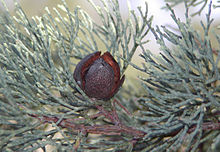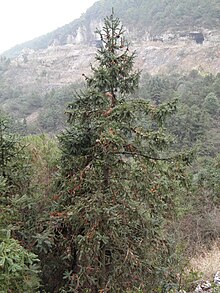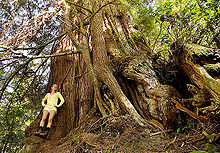Cypress family
| Cypress family | ||||||||||||
|---|---|---|---|---|---|---|---|---|---|---|---|---|

Giant sequoia ( Sequoiadendron giganteum ) |
||||||||||||
| Systematics | ||||||||||||
|
||||||||||||
| Scientific name | ||||||||||||
| Cupressaceae | ||||||||||||
| Gray |
The cypress family (Cupressaceae) form a plant family in the order of the conifers (Coniferales).
Cypress family (Cupressaceae see left) also include the bald cypress family ( Taxodiaceae ) , which used to be seen as an independent family . Within the conifers, the Cupressaceae are the only family that occurs on all continents and in both hemispheres of the earth - with the exception of Antarctica . The Cupressaceae have most of the genera within the conifers. However, only 133 recent species belong to this family. Many genera are assigned only one species.
description

Vegetative characteristics
It is always woody plants that grow as trees or bushes .
A common characteristic are the leaf organs, which are designed as needle or scale leaves. Often young shoots are completely covered by the crosswise opposite or whorled , scale-shaped leaf organs. The edge sheets on the side are distinguished from the surface sheets on the top and bottom (see schematic illustration). Face and edge sheets can differ both in size and shape. Seedlings have two to five cotyledons , with Taxodium there are up to nine cotyledons.
Generative characteristics
They are always of separate sex; mostly monoecious ( monoecious ); the junipers ( Juniperus ) are an exception and are dioecious ( dioecious ).
1 to 20 seeds are produced per cone. The seeds usually have no wings, there are also taxa with two to three wings on the seed.






habitat
The species that are grouped together in the Cupressaceae family can cope with very different habitat conditions. Some genera, such as thuja and sequoia, prefer humid habitats in coastal areas. Chamaecyparis and Taiwania , on the other hand, occur in high-lying monsoon forests. Some Juniperus species can also cope with poor rain conditions. Cupressus dupreziana is even found in the Tassili-n'Ajjer massif in Algeria's central Sahara . Together with the Sahara myrtle, they form a sparse tree population, 300 km from the nearest tree population. Depending on the source, there are only 153 to 213 individuals at this single location. The few specimens are part of the UNESCO - World Heritage and strongly threatened Tassili n'Ajjer extinction.
Systematics
The Cupressaceae family was established by John Edward Gray in A Natural Arrangement of British Plants , 2, pages 222, 225 in 1822 . A homonym is Cupressaceae Rich. et Bartling, this name was published in 1830 by Louis Claude Marie Richard in Friedrich Gottlieb Bartling : Ordines Naturales Plantarum eorumque characteres et affinitates adjecta generum enumeratione . Type genus is Cupressus L. Synonyms for Cupressaceae Gray nom. cons. are: Actinostrobaceae Lotsy , Arceuthidaceae AVBobrov & Melikyan , Athrotaxidaceae Nakai nom. inval., Athrotaxidaceae Doweld , Callitridaceae Seward , Cryptomeriaceae Hayata , Cryptomeriaceae Gorozh. , Cunninghamiaceae Zucc. , Cunninghamiaceae Siebold & Zucc. , Diselmaceae AVBobrov & Melikyan , Fitzroyaceae AVBobrov & Melikyan , Juniperaceae J.Presl & C.Presl , Libocedraceae Doweld , Limnopityaceae Hayata , Metasequoiaceae Hu & WCCheng , Metasequoiaceae Miki ex Hu & WCCheng , Microbiotaceae Nakai , Neocallitropsidaceae Doweld , Pilgerodendraceae AVBobrov & Melikyan , Platycladaceae AVBobrov & Melikyan , Sequoiaceae C. Koch ex Luerss. , Taiwaniaceae Hayata , Taxodiaceae Saporta nom. cons., Tetraclinaceae Hayata , Thujaceae Burnett , Thujopsidaceae Bessey , Widdringtoniaceae Doweld .
Cupressaceae are a very old group of plants: there are fossil records of Cupressaceae from the Jurassic , and molecular genetic data ( genetic distances ) can be calibrated with some of these fossils , whereby the biogeographical history of the family can be traced in detail.
In the cypress family (Cupressaceae) there are five or seven subfamilies with about 29 genera and about 142 species, depending on the author; many genera (17) are monotypical , i.e. consist of only one species:
- Subfamily Athrotaxidoideae Quinn : It contains only one genus:
- Subfamily Callitroideae Saxton : It contains five to ten genera (the scope of the genera is controversial):
- Actinostrobus Miq. : They are also placed under the genus Callitris by some authors. The three or so species occur only in the Australian state of Western Australia .
-
Austrocedrus Florin & Boutelje ): It contains only one species:
- Chile cedar ( Austrocedrus chilensis (D.Don) Pic.Serm. & Bizzarri : It only thrives in the mountains in central and south-central Chile and in south-western Argentina .
- Ornamental cypress ( Callitris Vent. ): The species are common in Australia and New Caledonia . The 15 to 19 species occur in all Australian states and in New Caledonia.
-
Diselma Hook. f. : It contains only one type:
- Diselma archeri Hook. f. : This endemic thrives at altitudes of 550 to 1400 meters only in western Tasmania.
-
Fitzroya Hook. f. ex Lindl. : It contains only one type:
- Patagonian cypress or Alerce ( Fitzroya cupressoides (Molina) IMJohnst. ): It occurs only in southern Chile (only in the Región de los Lagos ) and in south-western Argentina, i.e. in northern Patagonia .
- Libocedrus Endl. : The six species since 2012 occur in New Zealand (two endemic species), New Caledonia (three endemic species since 2012), southern Chile to southern Argentina (one species).
-
Neocallitropsis Florin }: It contains only one species:
- Neocallitropsis pancheri (Carrière) de foliage. (Syn .: Neocallitropsis araucarioides (Compton) Florin ): Some authors put it as Callitris pancheri (Carrière) Byng to the genus Callitis . It thrives in a few small populations along flowing waters over serpentine rock only in New Caledonia.
-
Papuacedrus H.L.Li : It contains only one species:
- Papuacedrus papuana (F.Muell.) HLLi : The two varieties since 1995 occur on the Moluccas and in New Guinea.
-
Pilgerodendron Florin : It contains only one species:
- Chilean river cedar ( Pilgerodendron uviferum (D.Don) Florin ): It occurs from southern Argentina to southern Chile. It has been part of Libocedrus since 2012 .
- Widdringtonia Endl. : The four to seven species occur from southern tropical Africa to southern Africa ( Malawi , Mozambique , Zimbabwe and South Africa ).
- Subfamily Cunninghamioideae (Sieb. & Zucc.) Quinn : It contains only one genus with about two species:
- Skewer fir ( Cunninghamia R.Br. ): The roughly two species occur in southern China, in Taiwan , Laos and Vietnam .
- Subfamily Cupressoideae Rich. ex Sweet : Since 2011 it only contains ten genres:
- Frankincense Cedar ( Calocedrus Kurz ): The four or so species come from southern China and Taiwan to northern Indochina and from Oregon to northwestern Mexico .
- False cypress ( Chamaecyparis spach ): The approximately five species are found in Japan , Taiwan, and the western and eastern United States.
- Cypress ( Cupressus L. s. L., Syn .: Xanthocyparis Farjon & THNguyên , Hesperocyparis Bartel & RAPrice , Neocupressus de Laub. , Callitropsis Oerst. ): It is divided into four subgenera. The 25 or so species are common in the Old and New World.
-
Fokienia A.Henry & HHThomas : It contains only one species:
- Fujian cypress ( Fokienia hodginsii (Dunn) A.Henry & HHThomas ): It is found in Laos, Vietnam and southern China.
- Juniper ( Juniperus L. ): The 67 to 75 species occur in the subarctic to temperate areas of Eurasia , in the mountains of tropical Africa, on the Caribbean islands and from North America via Mexico to Guatemala .
-
Microbiota Kom .: It contains only one species:
- Siberian dwarf tree or fan juniper ( Microbiota decussata Kom. ): This endemic occurs only in the northern part of the Primorye region .
-
Platycladus Spach : It contains only one species:
- Oriental arborvitae ( Platycladus orientalis (L.) Franco ): It is native to Russia's Far East, China and Korea.
- Tetraclinis mast. : It contains only one type:
- Arborvitae ( Thuja L. ): The five or so species occur in China, Japan, Korea and from Alaska to Canada and the United States.
-
Thujopsis Siebold & Zucc. ex Endl. : It contains only one type:
- Hiba tree of life ( Thujopsis dolabrata (L. f.) Siebold & Zucc .: It occurs in two varieties in Japan .
- Subfamily sequoias (Sequoioideae (Luerss.) Quinn ): It contains three species in three monotypical genera:
-
Sequoia Endl. : It contains only one type:
- Coast redwood ( Sequoia sempervirens (D.Don) Endl. ): It occurs in western North America only from southwestern Oregon to western California .
-
Sequoiadendron J.Buchholz : It contains only one species:
- Giant sequoia ( Sequoiadendron giganteum (Lindl.) J.Buchholz ): It only thrives in the Sierra Nevada in California.
-
Metasequoia Hu & WCCheng : It contains only one species:
- Dawn redwood ( Metasequoia glyptostroboides Hu & WCCheng ): It comes in the Chinese provinces of Chongqing , Hubei and Hunan ago.
-
Sequoia Endl. : It contains only one type:
- Subfamily Taiwanioideae (Hayata) Quinn : It contains only one genus:
- Subfamily Taxodioideae Endl. ex K. Koch : It contains three types:
-
Cryptomeria D.Don : It contains only one species:
- Sickle fir or Sugi ( Cryptomeria japonica (Thunb. Ex L. f.) D.Don ): It occurs in central to southern Japan. It is a neophyte in some areas.
-
Glyptostrobus Endl. : It contains only one type:
- Chinese cypress or water spruce ( Glyptostrobus pensilis (Staunton ex D.Don) K.Koch ): It occurs in central Laos , Vietnam and southern China.
- Bald cypresses ( Taxodium Rich. ): It contains only two species, which some authors also regard as two varieties of one species. The distribution area extends from the central and southeastern USA via Mexico to Guatemala.
-
Cryptomeria D.Don : It contains only one species:
swell
- Christopher J. Earle: The Gymnosperm Database , 2019: Cupressaceae . (English)
literature
- Colin Tudge: The secret life of trees. Penguin Books, London 2006, ISBN 978-0-14-101293-3 .
- PA Gadek, DL Alpers, MM Heslewood, CJ Quinn: Relationships within Cupressaceae sensu lato: a combined morphological and molecular approach. In: American Journal of Botany , Volume 87, Issue 7, 2000, pp. 1044-1057. Full text PDF.
- MJM Christenhusz, JL Reveal, A. Farjon, MF Gardner, RR Mill, MW Chase: A new classification and linear sequence of extant gymnosperms. In: Phytotaxa , Volume 19, 2011, pp. 57-70. doi : 10.11646 / phytotaxa.19.1.3
- Kangshan Mao, Richard I. Milne, Libing Zhang, Yanling Peng, Jianquan Liu, Philip Thomas, Robert R. Mill, Susanne S. Renner: Distribution of living Cupressaceae reflects the breakup of Pangea. In: Proceedings of the National Academy of Sciences = PNAS. Volume 109, No. 20, 2012, pp. 7793-7798, DOI: 10.1073 / pnas.1114319109 .
Individual evidence
- ^ Colin Tudge: The secret life of trees. Penguin Books, London 2006, ISBN 978-0-14-101293-3 , p. 104.
- ↑ Peter Schütt , Hans Joachim Schuck, Bernd Stimm (ed.): Lexicon of tree and shrub species. The standard work of forest botany. Morphology, pathology, ecology and systematics of important tree and shrub species . Nikol, Hamburg 2002, ISBN 3-933203-53-8 , pp. 126, 129 (reprinted 1992).
- ^ Colin Tudge: The secret life of trees. Penguin Books, London 2006, ISBN 978-0-14-101293-3 , p. 105.
- ↑ Cupressaceae in the Germplasm Resources Information Network (GRIN), USDA , ARS , National Genetic Resources Program. National Germplasm Resources Laboratory, Beltsville, Maryland. Retrieved March 20, 2019.
- ↑ a b Kangshan Mao, Richard I. Milne, Libing Zhang, Yanling Peng, Jianquan Liu, Philip Thomas, Robert R. Mill, Susanne S. Renner: Distribution of living Cupressaceae reflects the breakup of Pangea. In: Proceedings of the National Academy of Sciences . Volume 109, No. 20, 2012, pp. 7793-7798, DOI: 10.1073 / pnas.1114319109 .
- ↑ a b c d e f g h i j k l m n o p q r s t u v w x y z aa ab ac ad ae af ag ah ai aj ak al am an ao ap Rafaël Govaerts (ed.): Cupressaceae. In: World Checklist of Selected Plant Families (WCSP) - The Board of Trustees of the Royal Botanic Gardens, Kew . Retrieved March 19, 2019.
- ↑ a b c d e f g h i j k l m n o p Christopher J. Earle, 2019: Cupressaceae at The Gymnosperm Database .
- ^ A b Andrew B. Leslie, Jeremy M. Beaulieu, Hardeep S. Rai, Peter R. Crane, Michael J. Donoghue, Sarah Mathews: Hemisphere-scale differences in conifer evolutionary dynamics. In: Proceedings of the National Academy of Sciences , Volume 109, Issue 40, 2012, pp. 16217-16221.




